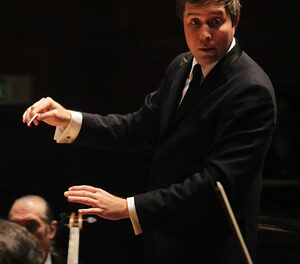A pretty full house was on hand Saturday night, October 20, in Greensboro’s War Memorial Auditorium for the second concert of the Greensboro Symphony Orchestra conducted by Stuart Malina. All three works featured brilliant orchestrations and accomplished musicianship.
The concert opened with Aaron Jay Kernis’ New Era Dance, commissioned as part of the 150th Anniversary of the New York Philharmonic in 1994. It has already been heard in the Triangle because Gerhardt Zimmermann programmed it during the 1999-2000 season of the North Carolina Symphony. Both conductors warned their audiences that the pistol fired was only part of the performance. Kernis tries to blend minimalism, popular song, Latin influences and even Rap in his works. New Era Dance is a celebration of modern urban life. It opens with a percussive, lurching rhythm. A siren joins the gunshot as part of a melee with brass. Melodic strings enter but the rhythm remains pulsing and repetitive and is taken up by the trumpet. A keyboard synthesizer joins the fray along with a sassy trombone slide. A shrill police whistle is heard over the driving rhythm and the whole orchestra repeats “New Era,” a rather cheap effect that dates the piece too much and which he ought to delete if he wants it to travel well. It is a cut above occasional pieces but I don’t think the Gershwin estate will worry that it will displace Rhapsody in Blue!
I was looking forward to hear pianist Andrew Armstrong perform the Second Piano Concerto in C Minor, Op. 18, by Sergei Rachmaninoff. I had been impressed by Armstrong’s sterling musicianship and virtuosity when I had heard him as a member of the Caramoor Virtuosi when they appeared on the city-sponsored Piccolo Spoleto Festival in Charleston, S.C. I was not disappointed as he stormed through as fine a live performance of the work as I have ever heard. With an excellent, well-tuned Steinway at his disposal, he displayed a remarkable dynamic range as well as sure and convincing phrasing. Malina had the orchestra in perfect balance and had them fit his soloist like a glove. A rich orchestral palate, so appropriate for the dour Russian, was produced. The violas were particularly rich. Principal Clarinetist Kelly Burke was first among several fine soloists within the orchestra.
The evening ended with a tightly controlled and fluent performance of one of the greatest works for orchestra of the 20th century, Béla Bartók’s Concerto for Orchestra. Malina secured a wide dynamic range and some outstandingly assured playing from every section. Playing of this level wasn’t possible from any orchestra in the Triad or Triangle a decade ago. The second movement, “Game of Pairs,” was the most entrancing. At the end, numerous players were asked to stand.
It seems to me that the audiences in Greensboro are much more diverse in age and race than in Raleigh. There are a lot more college-age and younger students to be seen. Raleigh seems to have a preponderance of retired or at least over-50 attendees. Both orchestras have generous discounts for students but Greensboro seems to succeed better in getting them into the hall. Those who are worried about audiences for classical concerts in the future – where will they come from? – might do well to study the GSO’s approach.











